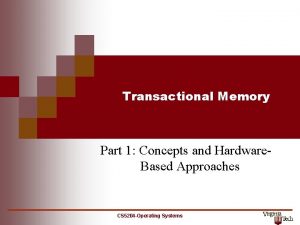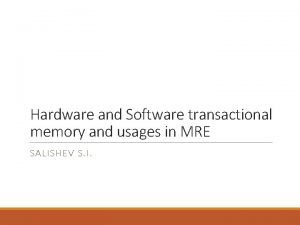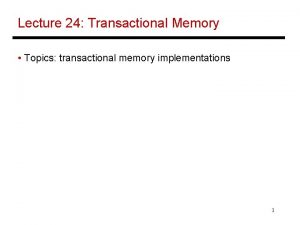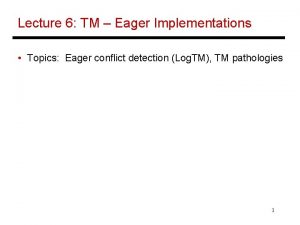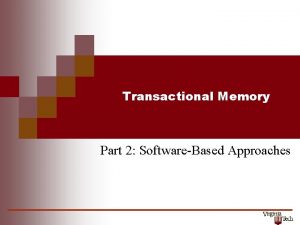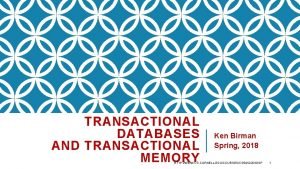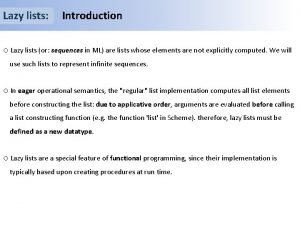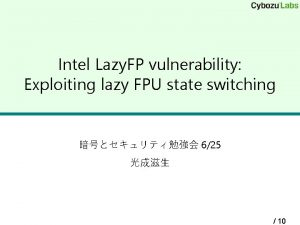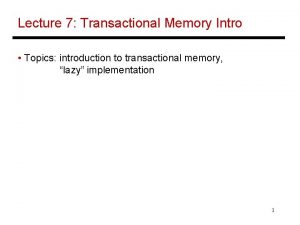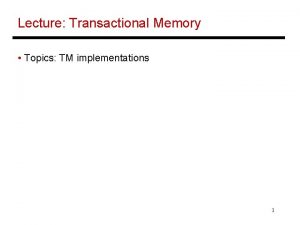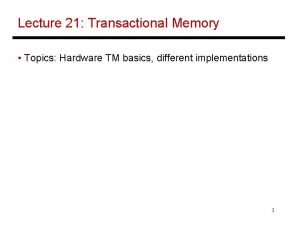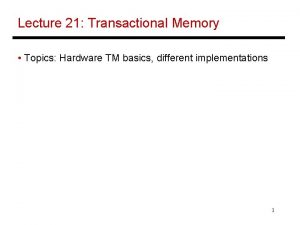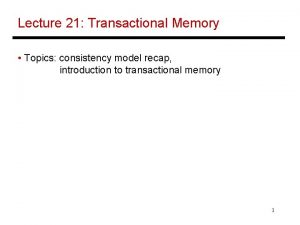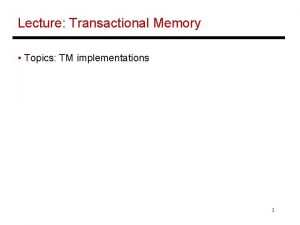Lecture 7 Lazy Eager Transactional Memory Topics details



















- Slides: 19

Lecture 7: Lazy & Eager Transactional Memory • Topics: details of “lazy” TM, scalable lazy TM, implementation details of eager TM 1

Lazy Overview Topics: • Commit order • Overheads • Wback, WAR, WAW, RAW • Overflow • Parallel Commit • Hiding Delay • I/O • Deadlock, Livelock, Starvation P P RW C M RW C A 2

“Lazy” Implementation (Partially Based on TCC) • An implementation for a small-scale multiprocessor with a snooping-based protocol • Lazy versioning and lazy conflict detection • Does not allow transactions to commit in parallel 3

Handling Reads/Writes • When a transaction issues a read, fetch the block in read-only mode (if not already in cache) and set the rd-bit for that cache line • When a transaction issues a write, fetch that block in read-only mode (if not already in cache), set the wr-bit for that cache line and make changes in cache • If a line with wr-bit set is evicted, the transaction must be aborted (or must rely on some software mechanism to handle saving overflowed data) (or must acquire commit permissions) 4

Commit Process • When a transaction reaches its end, it must now make its writes permanent • A central arbiter is contacted (easy on a bus-based system), the winning transaction holds on to the bus until all written cache line addresses are broadcasted (this is the commit) (need not do a writeback until the line is evicted or written again – must simply invalidate other readers of these lines) • When another transaction (that has not yet begun to commit) sees an invalidation for a line in its rd-set, it realizes its lack of atomicity and aborts (clears its rd- and wr-bits and re-starts) 5

Miscellaneous Properties • While a transaction is committing, other transactions can continue to issue read requests • Writeback after commit can be deferred until the next write to that block • If we’re tracking info at block granularity, (for various reasons), a conflict between write-sets must force an abort 6

Summary of Properties • Lazy versioning: changes are made locally – the “master copy” is updated only at the end of the transaction • Lazy conflict detection: we are checking for conflicts only when one of the transactions reaches its end • Aborts are quick (must just clear bits in cache, flush pipeline and reinstate a register checkpoint) • Commit is slow (must check for conflicts, all the coherence operations for writes are deferred until transaction end) • No fear of deadlock/livelock – the first transaction to acquire the bus will commit successfully • Starvation is possible – need additional mechanisms 7

TCC Features • All transactions all the time (the code only defines transaction boundaries): helps get rid of the baseline coherence protocol • When committing, a transaction must acquire a central token – when I/O, syscall, buffer overflow is encountered, the transaction acquires the token and starts commit • Each cache line maintains a set of “renamed bits” – this indicates the set of words written by this transaction – reading these words is not a violation and the read-bit is not set 8

TCC Features • Lines evicted from the cache are stored in a write buffer; overflow of write buffer leads to acquiring the commit token • Less tolerant of commit delay, but there is a high degree of “coherence-level parallelism” • To hide the cost of commit delays, it is suggested that a core move on to the next transaction in the meantime – this requires “double buffering” to distinguish between data handled by each transaction • An ordering can be imposed upon transactions – useful for speculative parallelization of a sequential program 9

Parallel Commits • Writes cannot be rolled back – hence, before allowing two transactions to commit in parallel, we must ensure that they do not conflict with each other • One possible implementation: the central arbiter can collect signatures from each committing transaction (a compressed representation of all touched addresses) • Arbiter does not grant commit permissions if it detects a possible conflict with the rd-wr-sets of transactions that are in the process of committing • The “lazy” design can also work with directory protocols 10

Scalable Algorithm – Lazy Implementation • Data is distributed across several nodes/directories • Each node has a token • For a transaction to commit, it must first acquire all tokens corresponding to the data in its read and write set – this guarantees that an invalidation will not be received while this transaction commits • After performing the writes, the tokens are released • Tokens must be acquired in numerically ascending order for deadlock avoidance – can also allow older transactions 11 to steal from younger transactions

Example Rd X Wr X P 1 T 1 P 2 T 2 D 1: D 2: XZ Rd Y Wr Z Y 12

“Eager” Overview Topics: • Logs • Log optimization • Conflict examples • Handling deadlocks • Sticky scenarios • Aborts/commits/parallelism P C Dir P RW C Dir RW Scalable Non-broadcast Interconnect 13

“Eager” Implementation (Based Primarily on Log. TM) • A write is made permanent immediately (we do not wait until the end of the transaction) • Can’t lose the old value (in case this transaction is aborted) – hence, before the write, we copy the old value into a log (the log is some space in virtual memory -- the log itself may be in cache, so not too expensive) This is eager versioning 14

Versioning • Every overflowed write first requires a read and a write to log the old value – the log is maintained in virtual memory and will likely be found in cache • Aborts are uncommon – typically only when the contention manager kicks in on a potential deadlock; the logs are walked through in reverse order • If a block is already marked as being logged (wr-set), the next write by that transaction can avoid the re-log • Log writes can be placed in a write buffer to reduce contention for L 1 cache ports 15

Conflict Detection and Resolution • Since Transaction-A’s writes are made permanent rightaway, it is possible that another Transaction-B’s rd/wr miss is re-directed to Tr-A • At this point, we detect a conflict (neither transaction has reached its end, hence, eager conflict detection): two transactions handling the same cache line and at least one of them does a write • One solution: requester stalls: Tr-A sends a NACK to Tr-B; Tr-B waits and re-tries again; hopefully, Tr-A has committed and can hand off the latest cache line to B neither transaction needs to abort 16

Deadlocks • Can lead to deadlocks: each transaction is waiting for the other to finish • Need a separate (hw/sw) contention manager to detect such deadlocks and force one of them to abort Tr-A write X … read Y Tr-B write Y … read X • Alternatively, every transaction maintains an “age” and a young transaction aborts and re-starts if it is keeping an older transaction 17 waiting and itself receives a nack from an older transaction

Block Replacement • If a block in a transaction’s rd/wr-set is evicted, the data is written back to memory if necessary, but the directory continues to maintain a “sticky” pointer to that node (subsequent requests have to confirm that the transaction has committed before proceeding) • The sticky pointers are lazily removed over time (commits continue to be fast) 18

Title • Bullet 19
 Lazy vs eager
Lazy vs eager Transactional memory
Transactional memory Hardware transactional memory
Hardware transactional memory C++ transactional memory
C++ transactional memory Hardware transactional memory
Hardware transactional memory Hardware transactional memory
Hardware transactional memory 01:640:244 lecture notes - lecture 15: plat, idah, farad
01:640:244 lecture notes - lecture 15: plat, idah, farad Minor details
Minor details Main idea major and minor supporting details
Main idea major and minor supporting details Shape memory alloys lecture notes
Shape memory alloys lecture notes Explicit memory
Explicit memory Which memory is the actual working memory?
Which memory is the actual working memory? Shared vs distributed memory
Shared vs distributed memory Long term memory vs short term memory
Long term memory vs short term memory Virtual memory
Virtual memory Internal memory and external memory
Internal memory and external memory Virtual memory in memory hierarchy consists of
Virtual memory in memory hierarchy consists of Semantic knowledge
Semantic knowledge Logical address
Logical address Primary memory and secondary memory
Primary memory and secondary memory




